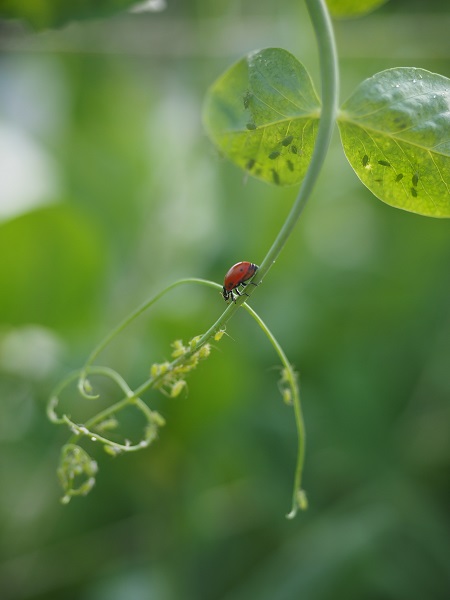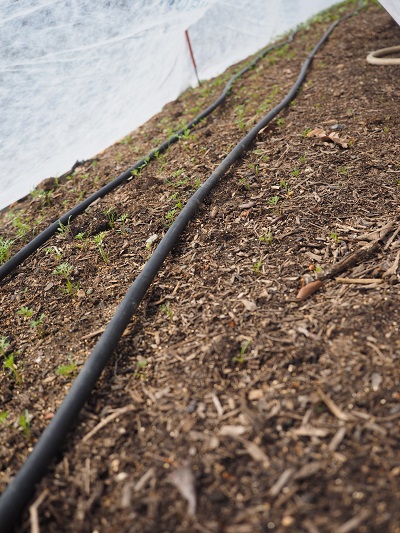We've had warm temperatures and descent rainfall the past couple of weeks, which has brought the spring garden to life. I love seeing the bright new green growth emerge from blank beds. Sprouting seedlings contain so much potential for delicious harvests. I find spring a season filled with inspiration from the germinating seed to the strawberry flowers.
Join me on an early spring tour of my garden.
Two weeks ago I planted asparagus crowns that looked lifeless and brown. I built a new raised bed using rocks, filled it with soil and buried the octopus-like root crowns.
Today I noticed that they've sprouted thin stalks! Either I was completely oblivious and missed seeing them emerge or they shot up out of the ground really fast. They are growing next to the pollinator flower bed and I've discovered that black-eyed susans disperse excessive amounts of seeds and will colonize the world (or at least my garden). I'm hoping the asparagus bed doesn't get overrun with black-eyed susans.
Now just a couple of years to wait for an asparagus harvest!
In the annual beds of my garden, lots of seedlings have sprouted and are putting on new growth. I overplanted spinach seeds because I had poor germination in the fall. All the seeds have sprouted and grown. I thinned and thinned some more, saving the miniature spinach leaves as microgreens to add to my salads. Spinach has a narrow window of growth in my climate because we tend to go from cool spring temperatures to the heat of summer suddenly. Hopefully the spinach will have time to grow before the heat arrives.
Peas germinated abundantly this spring. Yesterday I put up their trellis since they are growing and reaching into the sky for something to cling to. Last year aphids infected my peas, so I'm hoping for fewer aphids and more peas this spring. I still dream of having enough peas to freeze. It has yet to happen, but maybe this will be the year.
Spring planted turnips are abundant and green. They are living under a row cover this year because last year I had a destructive infestation of harlequin beetles.
Carrots are notorious for poor germination, but they are looking good this year. They are growing next to the turnips, so I ended up covering the entire root row. However, we had some strong winds a couple of days ago and those row covers did not want to stay put! A fifty foot row cover kite and strong winds makes for an entertaining scene for anyone watching, but not so fun for me!
Detroit red and golden beets sprouted too. My fall beets performed poorly this year, so I'm looking forward to a beet harvest.
Mustard is one of my new crops for 2017. I direct sowed them and they seem to be thriving.
Celery is my other experimental new crop for the year. I started them inside and transplanted them a couple of weeks ago. I need to thin them, but other than that they seem to be growing fine.
The little Cherry Belle radishes beat the competition for the first spring crops. I've never been a big radish fan, but I love to grow them since they are the closest crop to instant gratification you can get.
Fall planted garlic continues to grow and gets greener as spring gets warmer. I'm hoping for a good garlic harvest this year.
My overwintering cabbage looks ready for harvest. I harvested one head last week (2 lbs 11 oz), which is a good-sized cabbage for me! I used the first head in a potato and cabbage casserole. The next cabbage harvest will become coleslaw for a cookout this coming Friday for J's birthday.
And because gardening is a constant process, here's the newly planted cabbage seedlings. I need to thin them too!
Many of the herbs have put on new growth as spring arrives. My thyme looks lush and dense with little blooms.
Broccoli had a rough start this spring. We had an exceptionally warm February, but then in mid March, winter decided to return and we had a hard frost for several nights. At this point, my broccoli were tiny and I didn't have enough row covers and I assumed that they were cold hardy. They were too young and unprepared for the cold, so I had some causalities and do not have as many broccoli seedlings as I would like.
Potato stems and leaves have poked out of the ground. They too are protected under a row cover because I do not trust the potato beetles to leave anything for me.
I am delighted to see my strawberries flower and begin to form tiny, green berries. This year will be my first strawberry harvest. I planted them last year and I can't wait to taste the first delicious and juicy strawberry. I have a feeling that some squirrels may also be anticipating strawberries as much as me.
That is what is going on in my garden this spring. Soon it will be time to plant the summer crops. I have tomatoes, peppers, eggplants, squash, melons and okra growing in little pots waiting for the sun to warm the soil so that they can move out into the garden. I've been putting the seedlings on the back porch on warm days to help them acclimate to the sun. Our average last frost date is mid-April. That means that soon the gardening pace will pick up. Spring is a lovely time to observe the greening of the garden. It's always amazing to watch as the garden goes from empty soil to tiny seedlings that grow to towering plants producing abundant crops. Oh the miracles of spring!











































